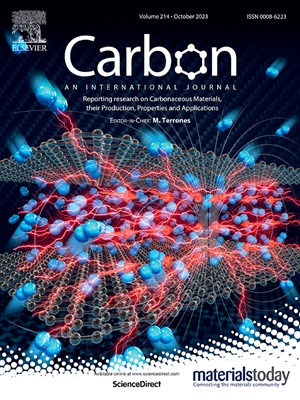Correlation study of graphitic shell encapsulated nickel: A multi-spectroscopic approach
IF 10.5
2区 材料科学
Q1 CHEMISTRY, PHYSICAL
引用次数: 0
Abstract
Graphite-encapsulated metal nanoparticles hold great potential across various applications due to their unique combination of metal and graphitic properties. While Raman spectroscopy is widely used to assess the graphitic shells, metrics derived from prominent Raman bands often prove unreliable when analyzing such structures with a large number of heterogeneous flakes and are mostly applicable to few-layer graphene. However, researchers continue to face challenges in identifying reliable metrics that accurately reflect two key properties of graphitic shells: thickness and degree of graphitization. In this study, graphitic shells were synthesized via plasma-enhanced chemical vapor deposition (PECVD) at low temperatures (500 °C), seeded by nickel nano-islands. A full-factorial experiment was designed to explore a diverse sample space by varying two key input factors: the initial thickness of the nickel seeding film and the duration of carbon deposition. Using resource-intensive surface characterization techniques (SEM, EDS, XPS, and AFM), we verified encapsulation efficiency and morphology, identifying strong correlations between the input factors and properties of the shells. To gain insights into structural characteristics, we employed conventional spectroscopy techniques (Raman, UV–Vis-nIR transmission, and Transient Absorption Spectroscopy), introducing 107 metrics derived from spectral data. Principal Component Analysis (PCA) aligned the input factors, and their corresponding shell properties, with the first two principal components. Accordingly, we identified the most relevant metrics including new candidates derived from less prominent Raman bands. Additionally, inter-metric correlations enable interchangeable use of spectroscopy techniques. This study marks the first multi-spectroscopic correlation analysis of graphitic shells and provides a novel framework for evaluating their properties.

石墨壳封装镍的相关性研究:多光谱方法
石墨封装的金属纳米粒子因其金属和石墨特性的独特结合而在各种应用中具有巨大潜力。虽然拉曼光谱被广泛用于评估石墨壳,但在分析具有大量异质薄片的此类结构时,从突出的拉曼光谱带得出的指标往往证明并不可靠,而且大多适用于少层石墨烯。然而,研究人员在确定能准确反映石墨壳两个关键特性(厚度和石墨化程度)的可靠指标方面仍然面临挑战。本研究在低温(500 °C)下通过等离子体增强化学气相沉积(PECVD)合成了石墨壳,并以纳米镍为种子。设计了一个全因子实验,通过改变两个关键输入因素(镍种子膜的初始厚度和碳沉积的持续时间)来探索多样化的样品空间。我们利用资源密集型表面表征技术(SEM、EDS、XPS 和 AFM)验证了封装效率和形态,确定了输入因素与外壳特性之间的密切联系。为了深入了解结构特性,我们采用了传统的光谱技术(拉曼光谱、紫外-可见-近红外透射光谱和瞬态吸收光谱),并引入了从光谱数据中得出的 107 个指标。主成分分析法(PCA)将输入因子及其相应的外壳特性与前两个主成分进行了排列。因此,我们确定了最相关的指标,包括从不为人知的拉曼波段中得出的新候选指标。此外,指标间的相关性使我们能够互换使用光谱技术。这项研究首次对石墨壳进行了多光谱相关性分析,为评估石墨壳的特性提供了一个新颖的框架。
本文章由计算机程序翻译,如有差异,请以英文原文为准。
求助全文
约1分钟内获得全文
求助全文
来源期刊

Carbon
工程技术-材料科学:综合
CiteScore
20.80
自引率
7.30%
发文量
0
审稿时长
23 days
期刊介绍:
The journal Carbon is an international multidisciplinary forum for communicating scientific advances in the field of carbon materials. It reports new findings related to the formation, structure, properties, behaviors, and technological applications of carbons. Carbons are a broad class of ordered or disordered solid phases composed primarily of elemental carbon, including but not limited to carbon black, carbon fibers and filaments, carbon nanotubes, diamond and diamond-like carbon, fullerenes, glassy carbon, graphite, graphene, graphene-oxide, porous carbons, pyrolytic carbon, and other sp2 and non-sp2 hybridized carbon systems. Carbon is the companion title to the open access journal Carbon Trends. Relevant application areas for carbon materials include biology and medicine, catalysis, electronic, optoelectronic, spintronic, high-frequency, and photonic devices, energy storage and conversion systems, environmental applications and water treatment, smart materials and systems, and structural and thermal applications.
 求助内容:
求助内容: 应助结果提醒方式:
应助结果提醒方式:


